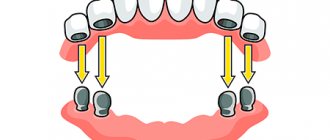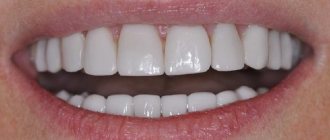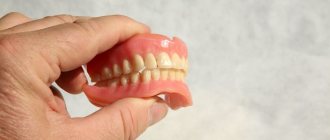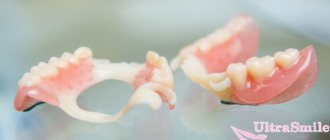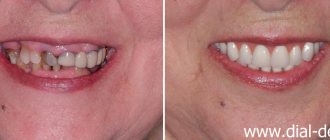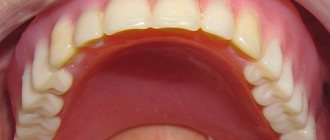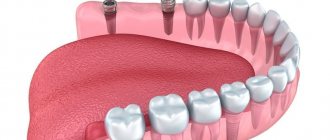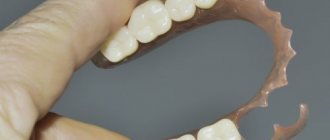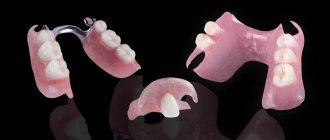In case of complete absence Means that improve fixation For partial removable For conditionally removable For fixed Fixation on implants
Dental prosthetics restores the dentition and its functions in the event of the loss of several or all teeth. Regaining the ability to chew normally, smile and speak safely changes patients' lives for the better. However, the success of prosthetics largely depends on how the dental prostheses are attached and how strong this attachment is.
Each type of orthopedic restoration has its own method of fixation, or even several.
The task of the orthopedist is to ensure not only fixation of dentures (holding them in the mouth at rest), but also stabilization (holding them while the jaws are working).
Why do you need spacers for dentures: application features and review of popular brands
Article navigation
- Why are fixing gaskets needed?
- Main characteristics of products
- Pros and cons of use
- In what cases can and should gaskets be used?
- Contraindications for use
- What brands of products are available for sale?
- How to use fixing pads
Question for a specialist
Removable dentures do not always bring positive emotions - they can cause discomfort, especially during adaptation. Special gaskets for dentures, which fix the structure in the oral cavity and prevent the appearance of unpleasant sensations, help correct the situation.
Reviews, opinions, comments
Practitioners in the field of dentistry agree that, despite the variety of linings used, they prefer materials based on aqueous suspensions or with chemical curing based on calcium hydroxide.
You can leave your opinions and comments at this point in this article.
If you find an error, please select a piece of text and press Ctrl+Enter.
Tags toothache
Did you like the article? stay tuned
Previous article
Recommendations from experts on how to properly care for your mouth guard
Next article
At what age is it advisable to take a child to an orthodontist?
Why are fixing gaskets needed?
Fixing spacers are used only for removable dentures. And they help eliminate the following problems:
- rubbing of the mucous membrane,
- foreign body sensation
- the appearance of irritation on the inner surface of the oral cavity,
- difficulty chewing,
- difficulty speaking,
- weak fixation of the product, loss.
Don't know what type of prosthetics to choose?
We will help in the selection, advise where to read more information and compare types of prosthetics.
Consultation with an orthopedic doctor in Moscow clinics is free! Call now or request a call
Working hours: from 9:00 to 21:00 - seven days a week
Due to the minimum possible thickness, the spacers do not affect the height of the bite. In addition, they do not change the taste of food and do not interfere with conversation. The use of products helps prevent all unpleasant sensations at the same time, so experts recommend using them immediately after prosthetics (if the situation was complicated and it is not possible to adjust the prosthesis so that it fits tightly to the gums).
Main characteristics of products
Various compounds can be included in the composition of dental dams, the main ones being: sodium alginate and carboxymethylcellulose. The first component ensures the retention of water molecules - by swelling, it improves shock absorption between the structure and the gum. It is of natural origin from algae and does not cause allergies.
Carboxymethylcellulose may cause an allergic reaction. The compound is intended to thicken the composition and stabilize the viscosity index. Also retains water.
The basis of the gaskets is polypropylene or viscose. Viscose fibers are characterized by excellent absorption capacity, porosity, and provide reliable adhesion to surfaces. Polypropylene fibers have a similar effect, but unlike viscose they are lint-free and more elastic. To enhance the fixing properties and provide additional lubrication, the material is additionally impregnated with petrolatum.
The retaining spacers for dentures differ in shape for the upper and lower jaws. For the lower rows they are made in a horseshoe shape, and for the upper rows - in the form of a semicircle.
On a note! Alginates are salts of alginic acid characterized by high hygroscopic properties. They attract and hold water molecules like collagen, a protein of animal origin, which is why such fixing pads are called collagen.
Materials used
In dental practice, various types of gaskets are used, which are made from the following materials:
- Calcium hydroxide. The pronounced bactericidal effect prevents the penetration of infectious pathogens into the pulp chamber.
In addition to its protective function, calcium hydroxide has a stimulating effect on the formation of secondary dentin. Prolonged contact with air causes a loss of the positive qualities of the material. - Aqueous mixtures containing calcium hydroxide. Used when placing temporary fillings.
They are applied in a thin layer to the bottom of the carious cavity, after which they are dried. To prevent the hydroxide from penetrating into the pulp, the dressing is changed after 3-6 weeks. In this case, materials such as Calcipulp, Calasept, Calcium Hydroxide are used. - Varnishes have good insulating properties, but have weak healing properties. They contain calcium hydroxide, zinc oxide, resin impurities and solvent. The varnish is applied to the cleaned tooth cavity, after which it is auscultated with a weak stream of air.
- Chemically cured gaskets. These types of pastes are prepared by mixing calcium hydroxide and ether in a 1:1 ratio.
Provide good insulating properties for spot installation with composite materials. They behave differently with cement compositions, as they have different degrees of compression. - Light-curing polymers. Despite the high degree of strength, they are rarely used, as they can (if handled carelessly) cause burns to the pulp. Also, the compositions have little therapeutic effect.
- Zinc-eugenol pastes. Used as an antiseptic before installing temporary fillings. Do not use with composite materials (due to the effect of eugenol).
In the video, a practicing dentist will talk about the features of materials created on the basis of calcium hydroxide.
Pros and cons of use
Among the advantages of using fixing gaskets are:
- reduction of the period of adaptation to removable dentures,
- additional fastening of the structure to the gums,
- the possibility of parallel use of other means for fixation or treatment,
- preventing inflammation of the mucous membranes,
- no effect on bite height,
- possibility of use even in the presence of dental deformations,
- versatility and safety.
The products are practically free of flaws. Of the minuses, users note only the high cost, and the possibility of developing allergic reactions to some components. But this is extremely rare.
OPERATIVE PROSTHETICS WITH ACRYLIC PROSTHETICS - from RUR 180,000.
Re-prosthetics with an acrylic bridge on a metal frame (all included) up to 12 units.
Save RUR 30,000. Call now or request a call
Attaching fixed dentures
Dentures that cannot be removed without damage are called non-removable.
These include:
- Crowns
. They help preserve severely damaged teeth and restore gaps in the dentition. - Bridges
. Designed to restore the function of a lost tooth. Unfortunately, in addition to grinding teeth for crowns, bridges have another drawback. With such prosthetics, bone tissue continues to decrease, bringing functional and aesthetic changes. - Dentures on implants
(if the denture is screw-fixed, it can be removed in the dentist’s office). The implant completely takes over the functions of the tooth. Stops bone loss and absorbs chewing load. - Microprostheses (veneers)
. Belong to aesthetic dentistry, their main goal is smile restoration
With the exception of implantation, a dental prosthesis is placed on the prepared unit with these methods. For veneers, the degree of preparation is small; only the top layer of enamel is removed.
For crowns, the tooth is ground down the more, the thicker the crown. The thickest metal-ceramic crowns. Modern ceramic compositions make crowns strong, light and thin. The thinnest products are made of zirconium dioxide. It is very hard and can withstand loads with minimal thickness.
If the coronal part of the tooth is severely damaged, the dentures must be fixed with a pin or stump inlay. This is a rod made of durable material, fiberglass or metal, which is inserted into the tooth canal. It serves as a support for restoration.
In what cases can and should gaskets be used?
Fixing spacers for dental prostheses are indicated during the patient's adaptation to the design. In addition, the doctor may prescribe the use of products in other cases:
- for abnormalities in the structure of the jaw that prevent the full use of dentures,
- when identifying chafing, ulcers, inflammation of the mucous membrane,
- with age-related changes in soft tissues,
- if there are disturbances in the functioning of the salivary glands (excessive or insufficient secretion),
- in case of malocclusion, when it is necessary to change the position of the removable structure.
Traumatic damage to the mucous membrane, such as a burn, can also be an indication. In this case, the gasket will protect the soft tissues from additional injury to the wound by the prosthesis and ensure speedy healing.
“Once I seriously damaged my gum with a fish bone, the doctor even had to cut it. Of course, it was not possible to wear a prosthesis because of the pain. The pads have helped a lot, now I keep them on hand and use them from time to time.”
Elena D., from correspondence on the e1.ru forum
Methods for fixing dentures in the absence of teeth
Keeping a removable laminar denture in the mouth at rest occurs due to a combination of several factors:
- Adhesion (sticking, adhesion)
. If there is a wet layer, 2 touching objects stick to each other. Moisture is provided by saliva. Its viscosity reduces or increases adhesion. However, this force alone is not enough to hold the structure. - Anatomical retention
. Protruding parts of the oral cavity limit the movement of the restoration. With significant bone loss, retention is significantly reduced. - Valve fixation
. When put on, the prosthesis slightly presses the mucous membrane, displacing air from under the base. The mucous membrane returns to its shape and does not allow air to flow back. A vacuum is formed. Due to the difference in pressure, the restoration is suctioned.
This is the main way that upper dentures are held in place. With lower structures the situation is more complicated. To fix them, you often have to resort to additional means.
Contraindications for use
The main contraindication to the use of retaining spacers for dentures is increased sensitivity to the components included in the composition. Since every body is individual, even products labeled “hypoallergenic” can cause allergies.
It is not recommended to use gaskets if the service life of the removable structure has long expired or it is damaged. Lack of hygienic care for the oral cavity and dentures also serves as an obstacle to use.
Fixation of conditionally removable dentures
Conditionally removable are structures that can be removed, but this requires certain manipulations. It is better to carry out this procedure at the dentist.
Dentures of this type are attached to implants
. There are 2 mounting methods: push-button and beam.
The beam method is the same as with clasp prosthetics. The beam acts as a patrix and is attached to the implants. And the matrix is located in the body of the prosthesis. Due to the beam, the chewing load is evenly distributed.
The push-button method also uses a patrix and a matrix, but there is no beam. The role of the male is performed by the abutment (transitional element).
What brands of products are available for sale?
There are three manufacturers of retaining spacers for dentures on the market. As a rule, there are no problems with where to buy products - they are available for sale in pharmacies, online stores in the relevant field, and you can also purchase them on the website of the manufacturer or representatives.
- Protefix (“Protefix”): characterized by strong adhesion, good shock-absorbing properties, and elasticity. The fixing effect lasts up to 8 hours. Soft pads "Protefix" are excellent for use in cases of abnormalities of the jaw bone tissue. They require preliminary wetting and are placed on a damp prosthesis. The cost of products ranges from 270 to 500 rubles for 30 pieces,
- Fittydent (“Fittydent”): pads from this manufacturer keep the denture in the mouth for 12 hours, regardless of the amount of saliva, the need for rinsing and other factors. They have increased softness, therefore they are indicated primarily for people prone to inflammatory processes of the mucous membrane. They do their job perfectly even with narrow lower dentures. The pads are placed on the dry prosthesis. The price of products on average ranges from 320 to 550 rubles for 15 pieces,
- Denture Fixing Tape: available as individual strips or as a continuous sheet rolled into a roll. This makes it possible to provide the most suitable shape and size. The thickness of the gaskets does not exceed 1/2 mm. Fixation does not depend on the dryness of the surface of the prosthesis, but requires preliminary targeted application of a fixing agent (for example, Corega cream) in the front part of the structure and along the edges. The price of products ranges from 320 to 530 rubles.
Protefix powder
The Protefix series fixing powder is ideal when the patient has minor problems with fixing a removable denture and has little salivation. The features of this drug are that it is easy to use.
To ensure that the prosthesis adheres well to the gum, it will be enough to sprinkle it with a thin layer of powder. After applying the drug, the structure will need to be put on as quickly as possible. The powder sets instantly. Fixation lasts for several hours. There is no way to tell the exact time. This will depend on the amount of liquid consumed, which washes away the drug.
If the prosthesis becomes loose, you can use the powder again. The prosthesis is carefully removed, rinsed and treated again with the drug. Excess drug is removed with running water.
Protefix powder is available in plastic bottles. When using it, do not squeeze the bottle around the edges. It will be enough to tilt it, tapping the body with your index finger to apply the required amount.
From reviews of doctors and patients: reliable and strong fixation, the ability to apply to a wet structure, ease of use and safety for health.
How to use fixing pads
To ensure optimal fixation of the gaskets, it is recommended to adhere to some rules for their use:
- the prosthesis must be clean,
- correction of products is carried out with scissors,
- Before use, you must remove the protective film,
- After placing the gasket on the surface of the structure, all gaps and air bubbles should be eliminated.
It is not advisable to eat or drink within 15-30 minutes after installing a prosthesis supported by such pads.
To fix removable dentures, you can use not only gaskets, but also other means and devices: powders, strips, adhesives, and so on. At the beginning of wearing the structure, the dentist will recommend the most suitable options, but the final choice can only be made through direct application.
Author: Mikhailova (. M. (Thank you for your help in writing the article and the information provided)
